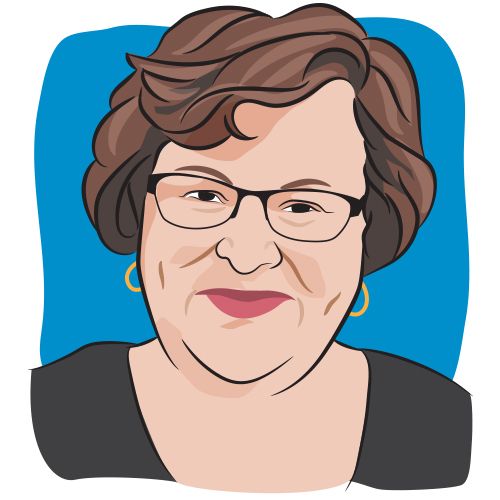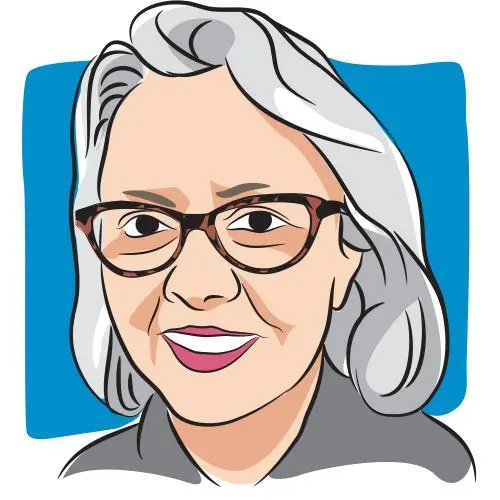Publication
Article
CURE
Braking Bad: Using Immunotherapy to Fight Hodgkin Lymphoma
Author(s):
By taking the brakes off immune response, immunotherapy empowers the body to fight resistant or recurrent classical Hodgkin lymphoma.
I have so much energy now! I never imagined that any of this would be possible. I’m very grateful that I was able to get nivolumab when I did.”<br><br> — ARIELLA CHIVIL , patient with Hodgkin lymphoma

I have so much energy now! I never imagined that any of this would be possible. I’m very grateful that I was able to get nivolumab when I did.”
— ARIELLA CHIVIL , patient with Hodgkin lymphoma
Ariella Chivil was diagnosed with Hodgkin lymphoma in the summer of 2010, just before her junior year at the University of Pennsylvania. Over the next four years, Chivil found that her disease was resistant to treatment as she went through 14 different protocols: multiple chemotherapy combinations, targeted therapies, radiation and clinical trials. She would experience most kinds of cancer treatment misery: nausea, crushing fatigue, difficulty eating and walking, weight loss, bowel obstructions, swelling, infections, surgeries and pain so severe it broke through massive doses of OxyContin. Finally, with few options left, Chivil’s hematology team put her on a harrowing “salvage” chemotherapy regimen. Yet just a few weeks later, a scan showed new tumor activity.
Then doctors suggested that Chivil try a new immunotherapy agent, Opdivo (nivolumab). The drug targets molecules that serve as a brake (or checkpoint) on the immune response — a process that normally keeps the immune system from becoming overactive, but which tumor cells may use to avoid immunological detection. By blocking these molecules, Opdivo unleashes the body’s full anti-cancer response.
In the past few years, Opdivo has gained U.S. Food and Drug Administration (FDA) approvals for the treatment of melanoma, lung cancer, renal cell carcinoma and most recently Hodgkin lymphoma, but when Chivil first tried it, the drug was still experimental for people with her disease. After trying so many treatments with little luck, Chivil says she was skeptical at first. But a few weeks after the first infusion, she began to feel better. As the weeks and months passed, she got stronger and stronger. After 18 months, doctors felt she was well enough to stop the infusions and adopt a “watch and wait” strategy. Now three years after that first infusion, Chivil enjoys the life of a normal 26-year-old: working for a medical technology firm, doing yoga, thinking about the future.
“I have so much energy now! I never imagined that any of this would be possible,” Chivil says. “I’m very grateful that I was able to get nivolumab when I did.”
Chivil was part of a small phase 1 study that had such dramatic results that the FDA gave Opdivo breakthrough therapy designation, expediting the review process for the drug as a treatment for her disease.
In May of this year, after a successful phase 2 trial and a safety study, the FDA approved Opdivo for use in patients with classical Hodgkin lymphoma (cHL) that has relapsed or progressed after stem cell transplant. This has not only created a treatment option for patients who once had none, but has also laid the groundwork for an active area of research, with nearly a dozen clinical trials currently recruiting patients for studies of Opdivo in different stages of cHL, in combination with similar agents and with various sorts of chemotherapies.
While dramatic effects have been seen in cHL, the type of Hodgkin lymphoma that comprises nearly all cases of the disease, Opdivo also seems likely to have a role in fighting many other cancers in addition to those in which it’s now approved. The number of Opdivo studies that are recruiting runs into the hundreds, if you expand the search to include all types of malignancies.
“It’s wild,” says Anas Younes, M.D., chief of the lymphoma service at Memorial Sloan Kettering Cancer Center and one of the authors of the phase 2 Opdivo trial. “These agents work in everything, to a variable degree. It’s advancing the response rate in almost all cancers.”
“As a clinician, I find it exciting to have a new treatment option for these cHL patients, who just did not have good options before,” adds Margaret Shipp, M.D., chief of the Division of Hematologic Neoplasia at the Dana-Farber Cancer Institute, in Boston.
OLD PRINCIPLE, NEW EXECUTION
The concept of immunotherapy — enlisting a patient’s own immune system to fight disease — has been around for more than a century. In the late 1800s, doctors noticed that patients who had infections after cancer surgery were less likely to have distant cancer recurrence. Researchers purified bacterial cultures and injected them into cancer surgery patients, hoping this would kick-start their immune systems. While the technique was quite successful, responses rarely lasted.
More recently, in the 1980s and 1990s, cancer researchers theorized that immune cells called T cells might be central to fighting cancer. They tried to use vaccines to stimulate T cell response in cancer patients, but results didn’t live up to the initial high hopes.
In the late 1990s and early 2000s, scientists realized that certain cancers seemed to have an ability to silence T cells, and that this seemed to be a dominant feature of cancers that spread.
How do the cancers do this? They hijack the body’s system of immune checkpoints. Immune cells do their job by looking at molecular markers on the surface of foreign organisms or cells. As immune cells “interrogate” other cells, their markers, or checkpoints, give various signals to the immune cell, such as “I am self, I’m no threat,” or “Divide to make more immune cells,” or, “I’m a foreign cell, kill me,” or “You’re no longer needed, self-destruct.” This allows the immune cells not to overreact and cause autoimmunity and destruction to normal tissues and organs.
What cancer cells might be doing, the researchers theorized, was using a “self-destruct” marker to trick the body’s T cells into suicide, thus weakening the body’s natural immune response.
In 1995, a research team identified such a marker: “cytoxic T-lymphocyte associated antigen-4,” or CTLA-4. Drugs were designed to target this marker, and Yervoy (ipilimumab) was approved in 2011 for the treatment of late-stage melanoma, and then given an additional indication in 2015 as a maintenance drug to prevent melanoma recurrence after surgery. In the early 2000s, researchers identified and characterized a similar marker called PD-1, or “programmed cell death protein 1.” Not long afterwards, researchers also discovered molecules that bind this cell receptor: “programmed death ligand 1” (PD-L1) and “programmed death ligand 2” (PD-L2).
Researchers started to design agents to target these checkpoints — antibodies that would block PD-1/PD-L1 interaction in cells. By 2012, various studies had shown that targeting this marker — using an artificial antibody to block it — turned out to be useful in fighting melanoma, lung cancer and kidney cancer. It also turned out that these drugs carried a lower risk of serious or life-threatening side effects than CTLA-4 inhibitors.
Meanwhile, a group of hematologists got together to discuss how this PD-1/PD-L1 pathway might be exploited in blood cancers, since they were thought to have a role in many such diseases. When a team genetically analyzed cHL tumor cells, its members found genetic changes that increased the number of these markers on the surface of tumor cells. “Upon genetic analysis of cHL, we found a high incidence of genetic alteration,” explains Shipp. “The tumor cells had increased gene copies in a specific region of chromosome 9, genes coding for PD-1, as well as those coding for PD-L1 and PD-L2.”
RESULTS WITH OPDIVO
This work and the insights it generated led to the development of antibodies interrupting the interaction between PD-1 markers and immune cells — just as the discovery of CTLA-4 had led to the immunotherapy Yervoy.
Opdivo is one such PD-1 checkpoint inhibitor, which works by blocking the cancer’s attempt to evade the immune system. It essentially takes the brakes off the immune system, making it possible to unleash the body’s full fury against the cancer.
The first test of Opdivo in cHL, a 2013 multi-center study of just 23 patients including Chivil, showed that 87 percent of participants responded. Doctors say that’s an astounding figure when response rates of 20 percent are often considered groundbreaking in oncology. In response, the FDA gave the treatment breakthrough status.
A larger phase 2 Opdivo study, with more patients and more varied disease profiles, still showed a response rate of 66 percent. And upon follow-up a year or two later, nearly half of the patients from the first study were doing well, suggesting to doctors that the responses may be “durable.”
“Hodgkin lymphoma turns out to be extremely sensitive to PD-1 blockage,” says Shipp. “Responses were long-lasting. Blocking this immune response was very important in terms of clinically meaningful responses in patients.” Even with excellent responses, side effects seemed less severe than with agents targeting CTLA-4. “Side effects are about what you would expect when you put the immune system on high alert: various kinds of inflammation, or autoimmunity — in the lung, in the colon,” Shipp says.
Side effects of both PD-1 and CTLA-4 immune checkpoint inhibitors can also include rash, diarrhea, endocrinologic problems such as overactive or underactive thyroid or underactive pituitary gland, and hepatitis or inflammation of the liver.
WHERE WILL IMMUNOTHERAPY FIT IN?
Specialists say that, going forward, Opdivo will be used in cases where patients don’t respond to older treatments. In the context of stem cell transplants, integrating this agent may be tricky, they say, since enhancing the immune system tends to aggravate “graft versus host” disease, in which a patient’s immune cells begin to attack the transplanted stem cells. Experts say Opdivo may also be used in patients who, for various reasons, can’t have stem cell transplants.
“There are also studies exploring whether PD-1 therapy could be used earlier in the course of the disease, or continued longer after a positive response,” says Philippe Armand, M.D., Ph.D, director of clinical research in the Lymphoma Program at Dana-Farber and an associate professor of medicine at Harvard Medical School.
“The goal is cure,” says Younes. “There’s still room for 15 percent of patients to (achieve) cure (who don’t reach that goal with other treatments). We want not just to improve the cure rate, but to improve the safety protocol.”
Two large phase 2 trials are investigating whether PD-1 immunotherapy might work for other kinds of lymphoma, such as non-Hodgkin, follicular and mediastinal large cell lymphomas.
Myriad other trials — although not strictly for patients with cHL — are recruiting patients for studies exploring how Opdivo might be used in combinations with other immunotherapy agents, such as Yervoy and the experimental anti-4-1BB immunotherapy urelumab; with kinase inhibitors Imbruvica (ibrutinib) and Sprycel (dasatinib); or with the antibody drug conjugate Adcetris (brentuximab vedotin). Other studies are combining Opdivo and Adcetris with traditional chemotherapy drugs.
“Usually, you have to shave doses to reduce toxicity, but not with brentuximab and nivolumab,” Younes says. “Here, you don’t have to cut the doses, and you get a 60 to 70 percent response rate. This is a really new opportunity to test new combination regimens. It’s a no-brainer.” Some of these combination trials base their approaches on specific genetic clues. Others are doing “signal searches,” just trying things out to see if a particular disease responds to a drug, thus creating a “signal.”
“Neither approach is necessarily better than the other,” Shipp says. “There are precedents for identifying new drugs with both approaches.”
Meanwhile, other PD-1/PD-L1 agents are coming down the pike: Keytruda (pembrolizumab) targets PD-1. Tecentriq (atezolizumab) targets PD-L1. Both have been approved for use in other cancers, and may also be effective in cHL, experts say.
“PD-1 and CTLA-4 represent the tip of the iceberg as ways to regulate T cells and other immune cells, and there’s a whole host of drugs now in development,” says Alexander Lesokhin, M.D., a hematologic oncologist at Memorial Sloan Kettering Cancer Center who was a coauthor on the first cHL PD-1 study. “These immune-modulating antibodies are all interesting avenues that are being explored. In the next five to 10 years, we’re going to see a lot of different combinations. It’s clear that immunotherapy is here, and will be incorporated into care for all patients in some form. We’re still really at the early stages of understanding its full potential.”





